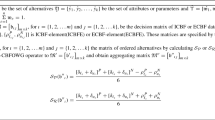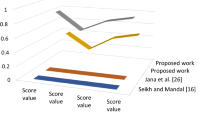Abstract
A cubic bipolar fuzzy set (CBFS) is a robust model which has the ability to simultaneously deal with bipolarity and vagueness by taking into account both interval-valued bipolar fuzzy sets (IVBFSs) and bipolar fuzzy sets (BFSs). Motivated by this innovative model, in the present article, some novel distance and entropy measures for CBFSs are proposed. Some operations on cubic bipolar fuzzy numbers (CBFNs) are also presented under P(R)-order by utilizing Einstein t-norm and t-conorm. For information fusion of CBFNs, several novel averaging aggregation operators are introduced based on Einstein operations named as P(R)-order cubic bipolar fuzzy (CBF) Einstein weighted averaging operator (P(R)-CBFEWAO), P(R)-order CBF Einstein ordered weighted averaging operator (P(R)-CBFEOWAO), and P(R)-order CBF Einstein hybrid weighted averaging operator (P(R)-CBFEHWAO). A new hybrid technique with Einstein averaging aggregation operators and CBF-VIKOR method is developed for multi-attribute group decision-making (MAGDM). A practical application of the suggested MAGDM technique towards the best renewable energy resource selection is presented. The applicability and feasibility of the newly proposed technique is analyzed by a comparative analysis of suggested technique with the already existing techniques.
Similar content being viewed by others
References
Akram, M., Waseem, N., Liu, P.: Novel approach in decision making with m-polar fuzzy ELECTRE-I. Int. J. Fuzzy Syst. 21, 1117–1129 (2019)
Alghamdi, M.A., Alshehri, N.O., Akram, M.: Multi-criteria decision-making methods in bipolar fuzzy environment. Int. J. Fuzzy Syst. 20, 2057–2064 (2018)
Atanassov, K.T.: Intuitionistic fuzzy sets. Fuzzy Sets Syst. 20(1), 87–96 (1986)
Aziz, N.: Biomass potential in Pakistan: bio-energy consultant. Available online at http://www.bioenergyconsult.com/biomass-pakistan (2015)
Beliakov, G., Pradera, A., Calvo, T.: Aggregation Functions: A Guide for Practitioners. Springer, Heidelberg (2007)
Chaudhry, M.A., Raza, R., Hayat, S.A.: Renewable energy technologies in Pakistan: prospects and challenges. Renew. Sustain. Energy Rev. 13, 1657–1662 (2009)
Cheng, S., Jianfu, S., Alrasheedi, M., Saeidi, P., Mishra, A.R., Rani, P.: A new extended VIKOR approach using q-rung orthopair fuzzy sets for sustainable enterprise risk management assessment in manufacturing small and medium-sized enterprises. Int. J. Fuzzy Syst. 23, 1347–1369 (2021)
Farooq, M.K., Kumar, S.: An assessment of renewable energy potential for electricity generation in Pakistan. Renew. Sustain. Energy Rev. 20, 240–254 (2013)
Garg, H.: Generalized pythagorean fuzzy geometric aggregation operators using Einstein t-norm and t-conorm for multicriteria decision-making process. Int. J. Intell. Syst. 32(6), 597–630 (2017)
Ghafoor, A., Rehman, T.U., Munir, A., Ahmad, M., Iqbal, M.: Current status and overview of renewable energy potential in Pakistan for continuous energy sustainability. Renew. Sustain. Energy Rev. 60, 1332–1342 (2016)
Gul, Z.: Some bipolar fuzzy aggregation operator and their application in multicriteria group decision making. Mphil Thesis (2015)
Hussian, Z., Yang, M.S.: Distance and similarity measures of pythagorean fuzzy sets based on Hausdorff metric with application to fuzzy TOPSIS. Int. J. Intell. Syst. 34, 2633–2654 (2019)
Jatoi, L.A.: Policy for development of renewable energy for power generation: government of Pakistan. Available online at http://www.aedb.org/Documents/Policy/REpolicy.pdf (2006)
Jun, Y.B., Kim, C.S., Yang, K.O.: Cubic sets. Ann. Fuzzy Math. Inform. 4, 83–98 (2012)
Jun, Y.B., Smarandache, F., Kim, C.S.: Neutrosophic cubic sets. New Math. Nat. Comput. 13, 41–54 (2017)
Khan, M.S.A.: The pythagorean fuzzy Einstein Choquet integral operators and their application in group decision making. Comput. Appl. Math. 38, 128 (2019)
Khan, M.J., Kumam, P., Alreshidi, N.A., Shaheen, N., Kumam, W., Shah, Z., Thounthong, P.: The renewable energy source selection by remoteness index-based VIKOR method for generalized intuitionistic fuzzy soft sets. Symmetry 977, 1–12 (2020)
Liu, D., Chen, X., Peng, D.: Some cosine similarity measures and distance measures between q-rung orthopair fuzzy sets. Int. J. Intell. Syst. 34, 1572–1587 (2019)
Opricovic, S., Tzeng, G.H.: Extended VIKOR method in comparison with outranking methods. Eur. J. Oper. Res. 178, 514–529 (2007)
Rani, P., Mishra, A.R., Mardani, A., Cavallaro, F., Streimikiene, D., Khan, S.A.R.: Pythagorean fuzzy SWARA-VIKOR framework for performance evaluation of solar panel selection. Sustainabilty 12, 4278 (2020)
Rauf, O., Wang, S., Yuan, P., Tan, J.: An overview of energy status and development in Pakistan. Renew. Sustain. Energy Rev. 48, 892–931 (2015)
Riaz, M., Salabun, W., Farid, H.M.A., Ali, N., Watrobski, J.: A robust q-Rung orthopair fuzzy information aggregation using Einstein operations with application to sustainable energy planning decision management. Energies 132155(13), 1–39 (2020)
Riaz, M., Tehrim, S.T.: Multi-attribute group decision making based on cubic bipolar fuzzy information using averaging aggregation operators. J. Intell. Fuzzy Syst. 37, 2473–2494 (2019)
Riaz, M., Tehrim, S.T.: Cubic bipolar fuzzy ordered weighted geometric aggregation operators and their application using internal and external cubic bipolar fuzzy data. Comput. Appl. Math. 38, 87 (2019)
Riaz, M., Tehrim, S.T.: Cubic bipolar fuzzy set with application to multi-criteria group decision making using geometric aggregation operators. Soft Comput. 24, 16111–16133 (2020)
Saqlain, M., Riaz, M., Saleem, M.A., Yang, M.S.: Distance and similarity measures for neutrosophic hypersoft set (NHSS) with construction of NHSS-TOPSIS and applications. IEEE Access 9, 30803–30816 (2021)
Schweizer, B., Sklar, A.: Probabilistic Metric Spaces. North Holland, New York (1983)
Shaikh, F., Ji, Q., Fann, Y.: The diagnosis of an electricity crisis and alternative energy development in Pakistan. Renew. Sustain. Energy Rev. 52, 1172–1185 (2015)
Siddiqi, A., Wescoat, J.L., Jr., Humair, S., Afridi, K.: An empirical analysis of the hydropower portfolio in Pakistan. Energy Policy 50, 228–241 (2012)
Solangi, Y.A., Tan, Q., Khan, M.W.A., Mirjat, N.H., Ahmed, I.: The selection of wind power project location in the southeastern corridor of Pakistan: A factor analysis, AHP, and fuzzy-TOPSIS application. Energies 11(8), 1–14 (2018)
Valasai, G.D., Uqaili, M.A., Memon, H.U.R., Samoo, S.R., Mirjat, N.H., Harijan, K.: Overcoming electricity crisis in Pakistan: a review of sustainable electricity options. Renew. Sustain. Energy Rev. 72, 734–745 (2017)
Wakeel, M., Chen, B., Jahangir, S.: Overview of energy portfolio in Pakistan. Energy Procedia 88, 71–75 (2016)
Wang, W., Li, X.: Intuitionistic fuzzy geometric aggregation operators based on Einstein operations. Int. J. Intell. Syst. 26(11), 1049–1075 (2011)
Wang, W., Li, X.: Intuitionistic fuzzy information aggregation using Einstein operations. IEEE Trans. Fuzzy Syst. 20(5), 923–938 (2012)
Wei, G., Alsaadi, F.E., Hayat, T., Alsaedi, A.: Bipolar fuzzy Hamacher aggregation operators in multiple attribute decision making. Int. J. Fuzzy Syst. 20, 1–12 (2018)
Wei, G., Wei, C., Gao, H.: Multiple attribute decision making with interval-valued bipolar fuzzy information and their application to emerging technology commercialization evaluation. IEEE Access 6, 60930–60955 (2018)
Xu, Z.S.: Intuitionistic fuzzy aggregation operators. IEEE Trans. Fuzzy Syst. 15(6), 1179–1187 (2007)
Yager, R.R.: Pythagorean fuzzy subsets. In: Proceedings of the joint IFSA world congress and NAFIPS annual meeting, pp. 57–61 (2013)
Yager, R.R.: Pythagorean membership grades in multi-criteria decision making. IEEE Trans. Fuzzy Syst. 22(4), 958–965 (2014)
Yager, R.R.: Generalized orthopair fuzzy sets. IEEE Trans. Fuzzy Syst. 25(5), 1220–1230 (2017)
Yang, M.S., Hung, W.L., Chang-Chien, S.J.: On a similarity measure between LR-type fuzzy numbers and its application to database acquisition. Int. J. Intell. Syst. 20(10), 1001–1016 (2005)
Yang, M.S., Hussian, Z.: Fuzzy entropy for pythagorean fuzzy sets with application to multicriterion decision making. Complexity 2832839, 1–14 (2018)
Yang, M.S., Tian, Y.C.: Bias-correction fuzzy clustering algorithms. Inform. Sci. 309, 138–162 (2015)
Zadeh, L.A.: Fuzzy sets. Inform. Control 8(3), 338–353 (1965)
Zadeh, L.A.: The concept of a linguistic variable and its application to approximate reasoning-I. Inform. Sci. 8(3), 199–249 (1975)
Zhang, W.R.: Bipolar fuzzy sets and relations. A computational framework for cognitive modeling and multiagent decision analysis. In: Proceedings of IEEE Conference Fuzzy Information Processing Society Biannual Conference, pp. 305–309 (1994)
Zhang, W.R., Zhang, L.: YinYang bipolar logic and bipolar fuzzy logic. Inform. Sci. 165, 265–287 (2004)
Zhang, W.R.: From equilibrium-based business intelligence to information conservational quantum-fuzzy cryptography-A cellular transformation of bipolar fuzzy sets to quantum intelligence machinery. IEEE Trans. Fuzzy Syst. 26(2), 656–669 (2018)
Acknowledgements
The authors would like to thank the anonymous referees for their helpful comments in improving the presentation of this paper. This work was supported in part by the Ministry of Science and Technology, Taiwan, under Grant MOST 110-2118-M-033-003.
Author information
Authors and Affiliations
Corresponding author
Ethics declarations
Conflict of interest
The authors declare that they have no conflict of interest.
Rights and permissions
Springer Nature or its licensor holds exclusive rights to this article under a publishing agreement with the author(s) or other rightsholder(s); author self-archiving of the accepted manuscript version of this article is solely governed by the terms of such publishing agreement and applicable law.
About this article
Cite this article
Riaz, M., Habib, A., Saqlain, M. et al. Cubic Bipolar Fuzzy-VIKOR Method Using New Distance and Entropy Measures and Einstein Averaging Aggregation Operators with Application to Renewable Energy. Int. J. Fuzzy Syst. 25, 510–543 (2023). https://doi.org/10.1007/s40815-022-01383-z
Received:
Revised:
Accepted:
Published:
Issue Date:
DOI: https://doi.org/10.1007/s40815-022-01383-z










